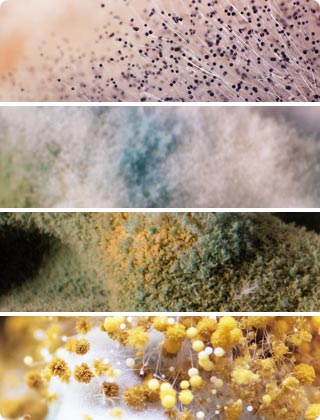MENU


An estimated 70% of homes have a mold problem. When this escalates, it can lead to issues with structural integrity. Mold also causes allergies among those predisposed to the condition: one in five people with allergies reacts negatively to mold.
Around 20% of people with allergies are vulnerable to mold, so it is vital to ensure that your interiors are mold-free. You don't want your family members to experience a coughing fit or rash. You also don't want to be responsible for a guest's allergic reaction. It is crucial to be aware of the most common types of mold in the home and how to prevent an infestation so your household enjoys a safe and clean environment at all times.
There are more than 100,000 types of mold, and only around a dozen of them grow inside homes. Here are eight of the most common ones:
Stachybotrys chartarum is a greenish-black mold that, according to the Centers for Disease Control and Prevention (CDC), grows on materials with high cellulose content. They may be seen around the following:
It grows and spreads when there is constant moisture in the area.
This type of mold is not directly linked to a specific health issue, but some experts are concerned it could cause acute idiopathic hemorrhage in infants. Those with allergies may experience rashes and stuffy noses. To prevent its growth, dry out the areas affected by water leaks, condensation, or flooding. Call for immediate mold inspection following heavy rain or snow that penetrate your interiors or if you experience a flood.
Penicillium has over 300 species with blue, green, and yellow spores. It is responsible for the spoilage of fruits and vegetables.
It can also be used to enhance some types of food, such as meat and cheese, and it naturally produces penicillin, the antibiotic. The mold is largely airborne, growing best in cool and damp environments. And like most molds found at home, it can cause allergic reactions among those with compromised immune systems.
Some Penicillium species contain mycotoxins, which are highly poisonous to humans when inhaled, ingested, or absorbed into the skin. With such danger, it is vital to call for mold inspection right away. O2 Mold Testing offers a full range of mold testing services to give homeowners peace of mind.
Alternaria is usually found in perennially damp, humid bathrooms. The large brown spores are replicated indoors only when there is a high concentration of Alternaria outdoors.
It is known to thrive in temperatures ranging from 34°F to 95°F. Around 5% of allergic people exposed to this mold may experience allergic rhinitis and asthma. The percentage is even higher among children.
Aspergillus is quite widespread in the environment, but most people can breathe it in without consequences. However, those with weak immune systems may experience allergic rhinitis, lung infection, infection in other organs, and aspergillosis.
Aspergillosis is an infection caused by Aspergillus. It is difficult to determine the number of people who got sick, but the invasive type reportedly keeps increasing by at least 3% each year.
Fusarium is commonly found in soil and plants. It has over 300 species that mostly thrive outdoors, but some find their way into homes. While it can be a menace to many crops, fusarium rarely affects humans.
However, immunocompromised individuals may experience osteomyelitis, pneumonia, and sinusitis. Such a mold may also release mycotoxins that may be cancerous or lead to serious diseases.
Aureobasidium is commonly found in soil, plants, marine estuary sediments, and wood. It can grow indoors, within these damp areas:
Aureobasidium causes allergic rhinitis and asthma in those with weak immune systems. In rare cases, it can also lead to skin lesions and keratitis.
Chaetomium has about 95 species with football-shaped dark brown spores. It thrives in cellulose-rich areas and digests it as it matures, which gives off a musty odor at home. It spreads indoors and outdoors.
Inside the home, you may see the mold in the following areas:
With over 500 species, Cladosporium is mostly safe for humans. However, those with weak immune systems may be prone to allergies and asthma upon exposure. Some may experience infections. It thrives in indoor and outdoor areas where there is moisture, humidity, and water damage. Cladosporium may be brown, green, or black. It can be found in the following areas: Attics, Basements, Bathrooms, Cabinets, Carpets, Fabrics, Floors, HVAC vent covers and grills, Painted surfaces, Paper, Wallpapers, Walls, Window sills, Wood
When you see some discoloration in some areas of your house, it may be time for you to learn how to detect mold in your home and call for professional cleaning and restoration services immediately. But first, your home must be tested for mold. O2 Mold Testing delivers certified laboratory reports to indicate the extent of your mold problem.
Here are some common health concerns caused by mold issues at home:
Also known as hay fever, people who inhale mold spores may experience allergic rhinitis. Symptoms include:
Many will experience the symptoms as soon as they inhale spores, while others have delayed reactions.
Mold allergy may also trigger asthma, which is a chronic lung disease. Those with asthma may experience the following upon mold exposure: coughing, chest tightening, shortness of breath, tightness in the chest and wheezing. According to the World Health Organization, asthma affected around 262 million people in 2019.
Immunocompromised people may also experience skin, nose, and eye irritation when exposed to some types of mold.
Anaphylaxis is an extreme form of hypersensitivity reaction that is sometimes fatal. It can be triggered by mold exposure and the release of chemicals that cause the person to go into shock.
Some types of mold contain mycotoxins that could cause cancer, complications during pregnancy, lung scarring, and other serious conditions.
Mold can be easily detected as some spores are visible to the eye. They discolor areas where they clump together in the bathroom, kitchen, and other damp corners and spaces. If left alone, the tiny spores will grow into a large colony that can weaken the structure it has taken over and find its way into the house's foundation.
Some mold infestations may not be immediately visible. For your household's safety, call for immediate mold inspection after situations that may have invited moisture into your home: heavy rains that penetrated the interiors, water leaks, flooding, and others.
When you suspect there is mold at home for any reason, call us immediately at 888-202-1680. Don't wait for the mold situation to worsen, as it could threaten your house's structural integrity and your family's health.